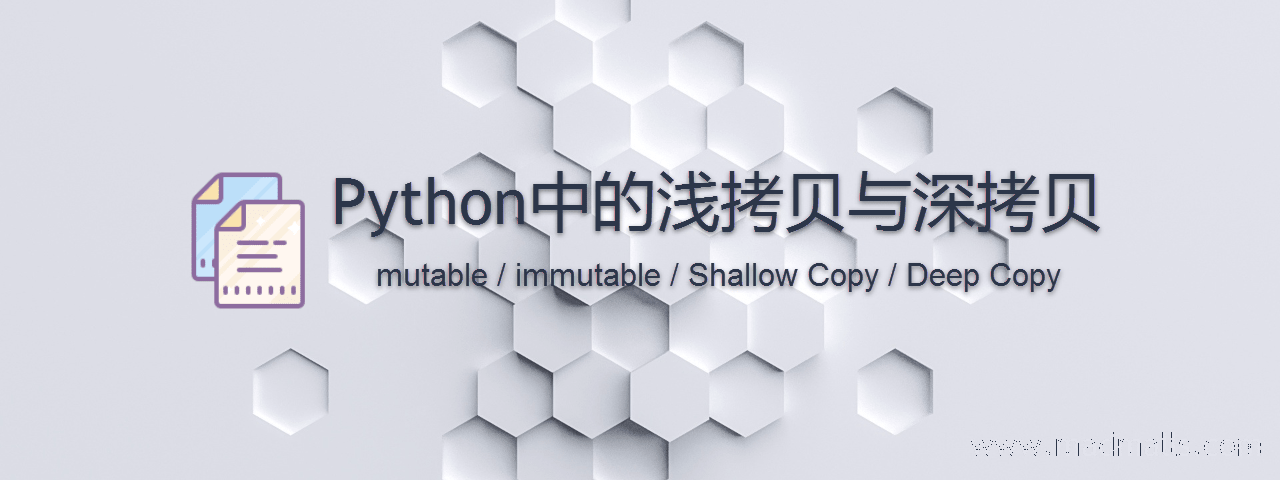理解Python浅拷贝和深拷贝的区别

Synopsis: Python赋值操作或函数参数传递,传递的永远是对象引用(即内存地址),而不是对象内容。在Python中一切皆对象,对象又分为可变(mutable)和不可变(immutable)两种类型。对象拷贝是指在内存中创建新的对象,产生新的内存地址。当顶层对象和它的子元素对象全都是immutable不可变对象时,不存在被拷贝,因为没有产生新对象。浅拷贝(Shallow Copy),拷贝顶层对象,但不会拷贝内部的子元素对象。深拷贝(Deep Copy),递归拷贝顶层对象,以及它内部的子元素对象
1. 可变对象与不可变对象
Python中一切皆对象,对象就像一个塑料盒子, 里面装的是数据。对象有不同类型,例如布尔型和整型,类型决定了可以对它进行的操作。现实生活中的"陶器"会暗含一些信息(例如它可能很重且易碎,注意不要掉到地上)。
对象的类型还决定了它装着的数据是允许被修改的变量(可变的mutable)还是不可被修改的常量(不可变的immutable)。你可以把不可变对象想象成一个透明但封闭的盒子:你可以看到里面装的数据,但是无法改变它。类似地,可变对象就像一个开着口的盒子,你不仅可以看到里面的数据,还可以拿出来修改它,但你无法改变这个盒子本身,即你无法改变对象的类型。
mutable: 可变对象,如List、Dictimmutable: 不可变对象,如Number、String、Tuple、Frozenset
注意: Python赋值操作或函数参数传递,传递的永远是对象引用(即内存地址),而不是对象内容。
In [1]: a = 1 In [2]: b = a In [3]: id(a) Out[3]: 9164864 In [4]: id(b) Out[4]: 9164864 In [5]: b += 1 In [6]: a Out[6]: 1 In [7]: b Out[7]: 2 In [8]: id(a) # 对象引用a还是指向Number对象1 Out[8]: 9164864 In [9]: id(b) # 对象引用b指向了Number对象2 Out[9]: 9164896
说明:
Python会缓存使用非常频繁的小整数-5至256、ISO/IEC 8859-1单字符、只包含大小写英文字母的字符串,以对其复用,不会创建新的对象:
1. 不会创建新对象 In [1]: a = 10 In [2]: b = 10 In [3]: id(a) Out[3]: 9165152 In [4]: id(b) Out[4]: 9165152 In [5]: a = '@' In [6]: b = '@' In [7]: id(a) Out[7]: 139812844740424 In [8]: id(b) Out[8]: 139812844740424 In [9]: a = 'HELLOWORLDhelloworld' In [10]: b = 'HELLOWORLDhelloworld' In [11]: id(a) Out[11]: 139812785036792 In [12]: id(b) Out[12]: 139812785036792
2. 会创建新的对象 In [1]: a = 1000 In [2]: b = 1000 In [3]: id(a) Out[3]: 140528314730384 In [4]: id(b) Out[4]: 140528314731824 In [5]: a = 'x*y' In [6]: b = 'x*y' In [7]: id(a) Out[7]: 139897777405880 In [8]: id(b) Out[8]: 139897777403808 In [9]: a = 'Hello World' In [10]: b = 'Hello World' In [11]: id(a) Out[11]: 139897789146096 In [12]: id(b) Out[12]: 139897789179568
2. copy模块
对象拷贝是指在内存中创建新的对象,产生新的内存地址。
-
浅拷贝只拷贝最外层对象,深拷贝还会递归拷贝内层对象
-
无论是浅拷贝还是深拷贝,只拷贝
mutable可变对象成为一个新对象,而immutable不可变对象还是原来的那个 - 当顶层对象和它的子元素对象全都是
immutable不可变对象时,因为没有产生新对象,所以不存在被拷贝
2.1 浅拷贝
浅拷贝(Shallow Copy),拷贝顶层对象,但不会拷贝内部的子元素对象。
(1) 顶层是mutable,子元素全是immutable
当顶层对象是mutable可变对象,但是它的子元素对象全都是immutable不可变对象时,如[1, 'world', 2]
① 创建列表对象并赋值给变量a
In [1]: a = [1, 'world', 2] In [2]: [ id(item) for item in a ] Out[2]: [9164864, 140104749066928, 9164896] In [3]: id(a) Out[3]: 140104759916040

② 导入copy模块,使用copy.copy()函数浅拷贝a,并赋值给变量b
In [4]: import copy In [5]: b = copy.copy(a) In [6]: b Out[6]: [1, 'world', 2] In [7]: [ id(item) for item in b ] Out[7]: [9164864, 140104749066928, 9164896] In [8]: id(b) Out[8]: 140104760027784

③ 修改变量a的子元素a[0] = 3,由于整数是不可变对象,所以并不是修改1变为3,而是更改a[0]指向对象3
In [9]: a[0] = 3 In [10]: a Out[10]: [3, 'world', 2] In [11]: b Out[11]: [1, 'world', 2] In [12]: [ id(item) for item in a ] Out[12]: [9164928, 140104749066928, 9164896] In [13]: [ id(item) for item in b ] Out[13]: [9164864, 140104749066928, 9164896]

(2) 顶层是mutable,子元素部分immutable
当顶层对象是mutable可变对象,但子元素也存在mutable可变对象时,如[1, 2, ['hello','world']]
① 浅拷贝copy.copy()只拷贝了顶层对象,没有拷贝子元素对象['hello','world'],即a[2]和b[2]指向同一个列表对象
In [1]: a = [1, 2, ['hello','world']] In [2]: import copy In [3]: b = copy.copy(a) In [4]: id(a) Out[4]: 139770596269064 In [5]: id(b) Out[5]: 139770596639368 In [6]: [ id(item) for item in a ] Out[6]: [9164864, 9164896, 139770596304840] In [7]: [ id(item) for item in b ] Out[7]: [9164864, 9164896, 139770596304840] In [8]: [ id(item) for item in a[2] ] Out[8]: [139770585378520, 139770585378408] In [9]: [ id(item) for item in b[2] ] Out[9]: [139770585378520, 139770585378408]














1 条评论
评论者的用户名
评论时间XXDDPAC
2020-03-05T06:36:16Zgood